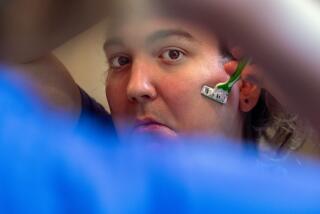Atlantis returns to Florida, ending a near-flawless trip
The space shuttle Atlantis landed safely at Kennedy Space Center in Florida on Wednesday, completing a nearly glitch-free 13-day construction mission to the International Space Station.
The seven-man crew delivered and installed the European-built Columbus laboratory, underscoring the international contribution to the giant metal island floating 220 miles above Earth.
The importance of the mission “is beyond what we accomplished,” said German astronaut Hans Schlegel after the touchdown at 9:07 a.m. EST.
Installation of the European lab serves as “a role model for international cooperation,” he said.
The landing, with shuttle commander Stephen N. Frick at the controls, went off without a hitch, despite a low-lying cloud bank over the central Florida coast.
Rex J. Walheim, an Air Force colonel making his second trip to the space station, said he was impressed by the sheer size of the station.
“It’s great to see how big the station is now,” said Walheim, who helped install a truss segment during his first mission in 2002.
“It really gets your attention” when the station appears in the shuttle windshield before docking, he said. It takes effort now to travel from one end of the station to the other, he added.
With the installation of Columbus, the station is 57% complete and weighs 567,856 pounds. When construction is completed, the space station will weigh just under 1 million pounds.
A lot of work remains. With the shuttle fleet scheduled for retirement in 2010, NASA must average four construction missions per year to finish on time. This year, five more are scheduled.
“These missions are extremely challenging, and a great deal of preparation and teamwork are required to get these vehicles ready to fly,” said William H. Gerstenmaier, NASA’s associate administrator for space operations.
Helping NASA along is the agency’s increasing confidence that engineers at last understand the debris problem that has bedeviled the craft since the loss of Columbia in 2003.
The cause of that accident was traced to a chunk of insulating foam that came off the external fuel tank and hit the shuttle’s left wing, tearing a hole in it.
Even after returning to flight, recent shuttle missions have been dominated by concerns that pieces of foam and ice continued to come off the fuel tank during launch. To deal with the problem, engineers redesigned the fuel tank. Exhaustive engineering studies also showed that debris strikes would be a concern only during a narrow time period when atmospheric pressures and acceleration are at their peak.
For Atlantis’ mission, safety officials were able to declare the shuttle safe for landing early in the flight, enabling the crew to turn their full attention to the construction tasks that took place during three spacewalks.
Besides installing the Columbus lab, the Atlantis crew retrieved a failed gyroscope, one of three that keep the station properly oriented in space, and brought it back to Earth.
Atlantis also brought Daniel Tani home after his nearly four-month stay in space as a member of the station’s crew. Left behind at the station was Leopold Eyharts, a French air force brigadier general.
Ground workers at Kennedy will begin preparing Atlantis for its next mission, an Aug. 28 flight to repair the Hubble Space Telescope.
The next shuttle launch will be Endeavor on March 11. It will attach a Japanese laboratory, called Kibo, or Hope, to the space station.
--
More to Read
Start your day right
Sign up for Essential California for news, features and recommendations from the L.A. Times and beyond in your inbox six days a week.
You may occasionally receive promotional content from the Los Angeles Times.






